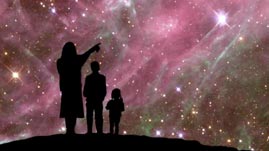Teachers' Domain - Digital Media for the Classroom and Professional Development
User: Preview

Source: NASA JPL/Caltech. Note: This media resource is not served or maintained by Teachers' Domain. To see the associated video files you will need Real Player.
Using telescopes tuned into wavelengths of the electromagnetic spectrum other than visible light, astronomers are able to see the universe in greater detail. The Spitzer Space Telescope, formerly called the Space Infrared Telescope Facility, studies stars and planetary systems in infrared wavelengths. In this video from NASA, learn about how infrared light can help us better understand the origins of the universe.
Infrared astronomy -- the study of the universe in infrared wavelengths -- is indispensable in understanding the universe as a whole. Since the detection of infrared radiation in 1800, these invisible wavelengths have led to many findings, including the discovery of the rings of Uranus, the detection of water vapor in the atmospheres of Jupiter and Saturn, the dramatic view of the core of the Milky Way Galaxy, and the first direct images of extrasolar planets.
Infrared light allows astronomers to see objects that are otherwise hidden from view. For example, near-infrared light is able to penetrate through gas and dust. In addition, far-infrared wavelengths allow cold objects such as dust to be seen, because objects that are too cool to be visible in other wavelengths can still emit infrared light. Infrared light also lets astronomers study the very young universe. Because of the expansion of universe, the wavelengths emitted by very distant objects have been stretched so much that they are now only visible in infrared wavelengths. Astronomers are able to use infrared light to study in greater detail the formation and evolution of planets, stars, and galaxies, as well as the distribution of matter throughout the universe.
Unfortunately, ground-based observations in infrared wavelengths are limited because infrared light is easily absorbed by Earth's atmosphere. Because of this, observatories that are located at high altitudes above most of the atmosphere, such as on Mauna Kea, are the most useful. In the 1960s and 1970s, astronomers tried to get better data by putting telescopes at even higher elevations using balloons, aircrafts, and rockets. However, in time they found that the best way to get around the absorption problem is to put observatories in space. Launched in 1983, the Infrared Astronomical Satellite (IRAS) was the first orbiting infrared observatory. IRAS detected hundreds of thousands of infrared sources, greatly increasing the number of cataloged objects. IRAS also observed disks of dust around nearby stars, providing the first evidence that there might be planets orbiting other stars.
Throughout the 1990s, technological advances improved the sensitivity and resolution of instruments, aiding our growing knowledge of the infrared universe. In 2003, the Spitzer Space Telescope, formerly called the Space Infrared Telescope Facility, was launched. As one of the four Great Observatories, Spitzer is able to image the infrared universe with unprecedented resolution.
 Loading Standards
Loading Standards Teachers' Domain is proud to be a Pathways portal to the National Science Digital Library.
Teachers' Domain is proud to be a Pathways portal to the National Science Digital Library.
